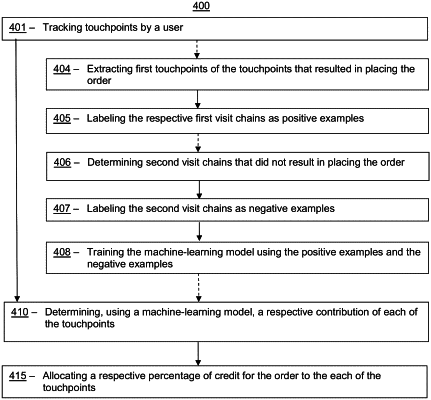| CPC G06Q 30/0243 (2013.01) [G06N 7/01 (2023.01); G06N 20/00 (2019.01); G06Q 30/0246 (2013.01); G06Q 30/0633 (2013.01)] | 20 Claims |

|
1. A system comprising:
one or more processors; and
one or more non-transitory computer-readable media storing computing instructions that, when executed on the one or more processors, cause the one or more processor to perform operations comprising:
tracking touchpoints of a set of touchpoints by a user over a first time period, wherein each of the touchpoints comprises a respective interaction by the user with one or more marketing channels regarding an item where the respective interaction led to an order of the item or a different item, wherein the respective interaction by the user comprises at least a respective passive interaction with the one or more marketing channels, and wherein at least a portion of the set of touchpoints comprises respective touchpoints that led to the order of the item or that led to the order of the different item that is unrelated to the item;
before receiving the order, classifying, using a first machine-learning model comprising a decision tree algorithm, training examples of each of the touchpoints of the set of touchpoints tracked along respective visit chains over the first time period, wherein the first machine-learning model is trained to label respective training examples as either a positive example or a negative example to separate short-term from long-term perception values;
after receiving the order, determining, using a second machine-learning model comprising a gradient boosting tree model, a respective contribution of each of the touchpoints, wherein the second machine-learning model is trained to predict a probability of the user placing the order during a timeframe based on an input feature vector representing the set of touchpoints, wherein the input feature vector comprises a history of time points along on a sequential timeline of a series of interactions by the user, and wherein training data for the second machine-learning model is iteratively updated on a periodic basis;
determining a respective percentage of credits to allocate toward each of the touchpoints based on the respective contribution of each of the touchpoints and the input feature vector; and
allocating the respective percentage of credit for the order to each of the touchpoints that led to a transaction of the order.
|